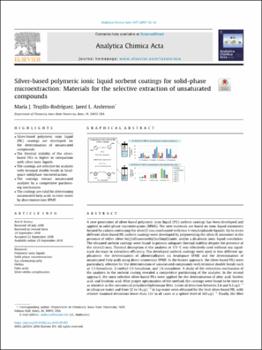Silver-based polymeric ionic liquid sorbent coatings for solid-phase microextraction: Materials for the selective extraction of unsaturated compounds
Fecha
2018Resumen
A new generation of silver-based polymeric ionic liquid (PIL) sorbent coatings has been developed and applied in solid-phase microextraction (SPME). The new materials are based on ionic liquid monomers formed bycations containing the silver(I) ion coordinated with two 1-vinylimidazole ligands. Up to seven different silver-based PIL sorbent coatings were developed by polymerizing the silver-IL monomer in the presence of either silver bis[(trifluoromethyl)sulfonyl]imide, and/or a dicationic ionic liquid crosslinker. The obtained sorbent coatings were found to possess adequate thermal stability despite the presence of the silver(I) ions. Thermal desorption of the analytes at 175 C was effectively used without any significant decrease in extraction efficiency. The developed sorbent coatings were used in two different applications: the determination of alkenes/alkynes via headspace SPME and the determination of unsaturated fatty acids using direct-immersion SPME. In the former approach, the silver-based PILs were particularly selective for the determination of unsaturated compounds with terminal double bonds such as 1,5-hexadiene, 2-methyl-1,5-hexadiene, and 1,8-nonadiene. A study of the extraction mechanism of the analytes to the sorbent coating revealed a competitive partitioning of the analytes. In the second approach, the most selective silver-based PILs were applied for the determination of oleic acid, linoleic acid, and linolenic acid. After proper optimization of the method, the coatings were found to be more or as sensitive as the commercial polydimethylsiloxane fiber. Limits of detection between 2.6 and 8.2mgL 1 in ultrapure water and from 12 to 14mgL 1 in tap water were obtained for the best silver-based PIL, with relative standard deviations lower than 13% in all cases at a spiked level of 160mgL 1. Finally, the fiber was effectively applied for the analysis of rinse water from a dairy farm, with adequate detection of the analytes at concentrations between 52 and 179mgL 1





